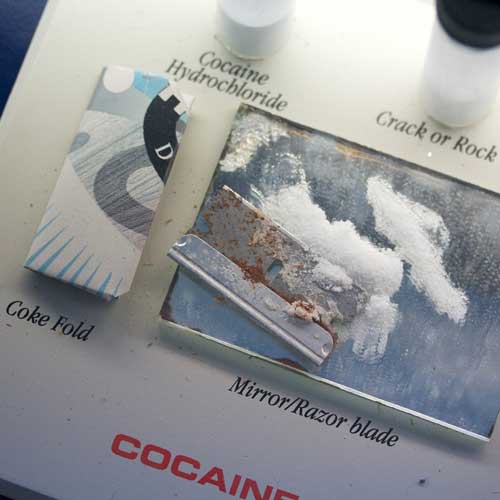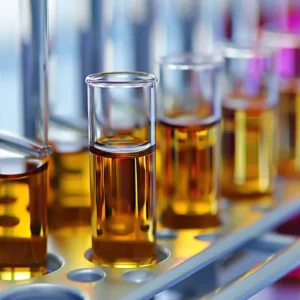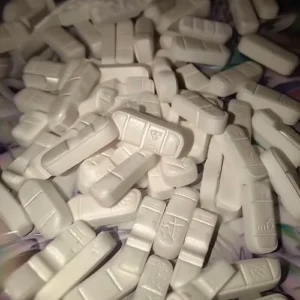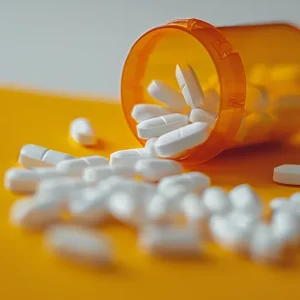There are many types of Cocaine in the world today. They are all fundamentally similar though and will be detected by cocaine drug testing kits This article identifies the most common forms of cocaine that you may encounter.
Cocaine Hydrochloride
In the UK cocaine hydrochloride is the most common form of cocaine that is used. This is the white crystalline powder we commonly see which is usually pure cocaine but contains fillers such as baking soda, flour, talcum powder, creatine, lidocaine, or sugars such as glucose. This is sold in wraps or vials which are made from aluminium foil, plastic, or paper.
In the Western world this type of cocaine is sniffed or snorted which goes by the technical name “insufflation.” The cocaine is absorbed into the nasal passages and into the mucus membranes located there. If any cocaine is left over its swallowed because this type of cocaine is water soluble and gets trapped in the mucous.
Rails or bumps are the “white lines” of cocaine where the cocaine is cut up by a razor on a mirror or another hard surface and the cocaine is snorted though some type of tube which are often referred to as “tooters.” In many cases this is a rolled bill, a straw, or a biro pen among other items. At some parties the straws are said to be made out of silver so the lipstick won’t come off of the woman who snorts the cocaine although this can’t be confirmed. After the cocaine is snorted some is sometimes rubbed into the gums which can numb them because cocaine has some anaesthetic properties.
Freebase
Another form of cocaine is called freebase. In this form of cocaine most of the adulterants or fillers are removed as well as the hydrochloride salt. This process is quite dangerous however as ether and other explosive chemicals are needed. The freebase isn’t soluble in water so it’s smoked and not injected, inhaled, or snorted.
Crack Cocaine
Another form of freebase cocaine is called “crack” cocaine. It is called crack because it makes a noise when it is heated. The cocaine powder is heated with water and baking powder or ammonia. Once the cocaine has cooled it looks like small rocks or pellets and is beige or has a creamy white colour to it. The colour all depends on the purity of the cocaine used. This is sold in vials or small bags with enough for two or three hits. Crack and freebase cocaine are often smoked through a glass tube. Sometime seven an empty soft drink can with holes poked in the can is used as a pipe. When a flame is held near the rock of cocaine vapour is produced and this is then inhaled. Freebase cocaine produces an intense high and a rapid rush when it’s smoked. The cocaine enters the bloodstream quickly when it’s smoked and it will hit the brain in seconds.
Speedball
Cocaine that is injected will also hit the brain quickly and this drug is powdered and mixed with water. A syringe is used to inject the solution into the bloodstream. Heroin is often mixed with cocaine and injected this way in what is referred to as a “speedball.” Many famous people have died this way such as River Pheonix and John Belushi. The injected cocaine is more potent because the full amount of the cocaine gets into the bloodstream. Some of the cocaine escapes in the vapour when it’s only smoked.
Snow Bomb
Some cocaine is taken orally but this isn’t very common in the Western world. Cocaine is rubbed into the gum line. One way to take it orally is to wrap it in paper and swallow it in what is called a “snow bomb.” In the Andes some of the indigenous people there make a coca tea or they chew the leaves. The tea helps with altitude sickness and to relieve hunger pangs. Coca-Cola in the late nineteenth century got its name because one of the main ingredients was a liquid extract from the coca leaf and the Kola nut with some cocaine present. There’s a non-narcotic extract used today that does not contain any cocaine which is used to make Coca-Cola.
Photo Credit: “” (CC BY 2.0) by Marcin Wichary
Zoom Testing is a leading UK drug testing company and a supplier of Drug Test Kits.
This post was originally published in June 2013.





